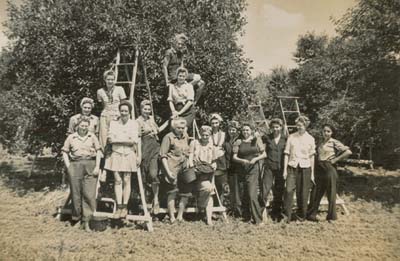Farmerettes in the Field
The Women's Land Army at Media Farm
By Patricia Wilkins

In 1944, women from 18 West Virginia counties traveled to farms in northern Ohio to harvest crops, as seen here.
Photograph courtesy of the Mary Tyson Owens Collection.
Since the American Revolution, women have played important roles in military conflict and on the home front. As the nature of war changed, women adapted, whether they supported war or simply wanted to hasten peace. In the absence of their husbands, women ran farms and businesses and proved that they were capable.
This is the story of Women’s Land Army recruits who worked on a farm in West Virginia during World War I.
Clouds of war rolled across the Shenandoah Valley the spring of 1917, creating a storm of uncertainty for Jefferson County farmers. Cultivation and planting were delayed by April snow and killing frosts in May.With the slogan “Food Will Win the War,” President Woodrow Wilson called on farmers to aid the war effort by producing more crops.
Labor scarcity and a looming food shortage called for the unconventional. Homemakers signed food pledge cards, enlisted in canning armies, and planted war gardens. The ladies of the Woman’s National Farm & Garden Association and Garden Club of America had a practical idea to save the food supply. With the help of the Women’s Committee of the Council of National Defense and the Young Women’s Christian Association, women were organized into experimental units to replace men on farms.
Women from all walks of life embraced the land-army movement as a patriotic call to arms. Full of enthusiasm and good intentions, they were called “farmerettes.” They cast aside convention; packed a bag with overalls, old shoes, and a big straw hat; rolled up their sleeves; and let the farmers know they were ready to work.
Overcoming the farmers’ skepticism was the challenge.
During this crucial time, John Yates McDonald was welcomed home to Media Farm, near Charles Town. McDonald was 30 when he graduated from Oregon Agricultural College. His brother Marshall managed the farm until he went to war. Brother Percy also was called for duty in France. John was the youngest of six brothers, and now only brother Will remained on a farm that had belonged to their ancestors for generations.
Before America entered the war, the McDonald brothers had been in discussions with agricultural students from the University of Wisconsin to help with farm work that summer.
As the merit of women on the land was debated in Congress, at agricultural meetings, and in farmhouse kitchens, the McDonald clan made a bold move to not only invite the college students to work at Media Farm, but also to build an orchard cottage for the farmerettes.
The McDonald brothers were enthusiastic about a Woman’s Land Army. They told a reporter from the Farmers Advocate that they thought employing the farmerettes would “release some men for other farms.”
Esther Louise Forbes, a senior at the University of Wisconsin, was one of the first women to sign up. Forbes told the Worcester Evening Gazette: “When suddenly the idea presented itself, the idea of working on a 500-acre farm near Harpers Ferry seemed to hold great fascination. The labor situation was desperate, and anything was worth a gamble.”
Girl Scouts and high school girls stepped up “to do their bit” on the farms. Schools allowed students to leave class and earn credit for pitching in for the war effort. Dozens of girls from Charles Town High School and St. Hilda’s Hall, a girl’s finishing school, helped harvest the apple crop the fall of 1917.
Farmerette Carlotta Lowell Taber told the Gazette: “It is the patriotic duty of young college graduates who are not otherwise employed to go out into the fields and help gather the harvests. The men are enlisting and being drafted into the country’s service, and the effect is already being felt on the farms.”
Taber, who studied agriculture at Cornell for two years after graduation from Bryn Mawr, said: “If a girl is able to learn the various kinds of apples and to know the trees by their barks, there is no need for close supervision by overseers. The apple trees flourish best if planted helter-skelter, but the pickers must go from one tree to another of the same kind, to keep the various brands of apples separate.
You can read the rest of this article in this issue of Goldenseal, available in bookstores, libraries or direct from Goldenseal.